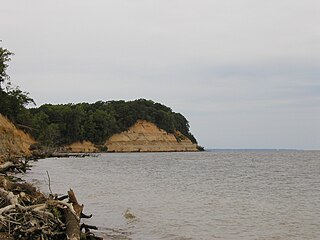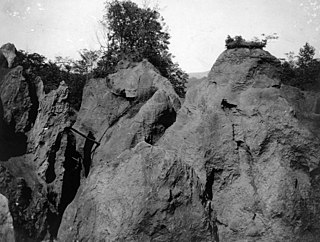
Carcharodon is a genus of sharks within the family Lamnidae, colloquially called the "white sharks." The only extant member is the great white shark. The extant species was preceded by a number of fossil (extinct) species including C. hubbelli and C. hastalis. The first appearance of the genus may have been as early as the Early Miocene or Late Oligocene.

Calvert Cliffs State Park is a public recreation area in Lusby, Calvert County, Maryland, that protects a portion of the cliffs that extend for 24 miles along the eastern flank of the Calvert Peninsula on the west side of Chesapeake Bay from Chesapeake Beach southward to Drum Point. The state park is known for the abundance of mainly Middle Miocene sub-epoch fossils that can be found on the shoreline.

The Aquia Formation is a geologic sandstone formation that extends from the upper Chesapeake Bay to the James River near Hopewell, Virginia. It consists of clayey, silty, very shelly, glauconitic sand. Fossil records indicate that this stratigraphic unit was created during the Paleocene.

The Monongahela Formation is a geologic formation in West Virginia, Pennsylvania, Ohio, and Maryland. It preserves fossils dating back to the Carboniferous and Permian periods.

The Chesapeake Group is a geologic group in Maryland, Virginia, Delaware, and North Carolina. It preserves mainly marine fossils dating back to the Miocene and Pliocene epochs of the Neogene period. This group contains one of the best studied fossil record of Neogene oceans in the world. Professional Paleontologists and amateur fossil hunters alike collect from this group intensely. The Calvert Cliffs stretch the length of Calvert County, Maryland and provide the best continuous stretch of the Calvert, Choptank, and St. Marys Formations. Ward (1985) recommended including the Old Church Formation in this group.

The Roubidoux Formation is a geologic formation in the Ozarks of Missouri and in Virginia. It preserves fossils dating back to the Ordovician period.

The Rockdale Run Formation is a geologic formation in Maryland, Pennsylvania, Virginia and West Virginia. It preserves fossils dating back to the Ordovician period.
The St. Marys Formation is a geologic formation in Maryland and Virginia, United States. It preserves fossils dating back to the Miocene Epoch of the Neogene period. It is the youngest Miocene formation present in the Calvert Cliffs and is part of the Chesapeake Group.

The Old Church Formation is a geologic formation in Virginia and possibly Maryland. It preserves fossils dating back to the Oligocene epoch of the Paleogene period. It rarely exposes on land and is under-studied. However, deposits from this period are rare and the Old Church Formation likely contains many scientifically significant taxa. Ward (1985) recommended placing this formation in the Chesapeake Group.

The Choptank Formation is a geologic formation in Virginia and Maryland. It preserves fossils dating from the Miocene epoch of the Neogene period.
The Piney Point Formation is a geologic formation in Virginia. It preserves fossils dating back to the Lutetian Stage of the Eocene Epoch of the Paleogene period.

The Tomstown Dolomite or Tomstown Formation is a geologic formation in Maryland, Pennsylvania, Virginia and West Virginia. It preserves fossils dating to the Cambrian Period.
The Conasauga Formation is a geologic formation in Georgia. It preserves fossils dating back to the Cambrian period.
The Alachua Formation is a Miocene geologic formation in Florida. The claystones, sandstones and phosphorites of the formation preserve many fossils of mammals, birds, reptiles and fish, among others megalodon.
The Bashi Formation is a geologic formation in Alabama and Mississippi. It is named for Bashi Creek in northern Clarke County, Alabama, which cuts through some of its exposures. It preserves fossils dating back to the Eocene period, or Wasatchian in the NALMA classification.
The Sheep Pass Formation is a geologic formation in Nevada. It preserves fossils dating back to the Paleogene period.
The Temblor Formation is a geologic formation in California. It preserves fossils dating back from the Late Oligocene to the Middle Miocene of the Neogene period. It is notable for the famous Sharktooth Hill deposit.
The Jewett Sand Formation is a geologic formation in California, USA. It preserves fossils dating back to the Miocene Epoch of the Neogene period.

Alopias palatasi, commonly referred to as the serrated giant thresher, is an extinct species of giant thresher shark that lived approximately 20.44 to 13.7 million years ago during the Miocene epoch, and is known for its uniquely serrated teeth. It is only known from such isolated teeth, which are large and can measure up to an excess of 4 centimetres (2 in), equating to a size rivaling the great white shark, but are rare and found in deposits in the East Coast of the United States and Malta. Teeth of A. palatasi are strikingly similar to those of the giant thresher Alopias grandis, and the former has been considered as a variant of the latter in the past. Scientists hypothesized that A. palatasi may have had attained lengths comparable with the great white shark and a body outline similar to it.













